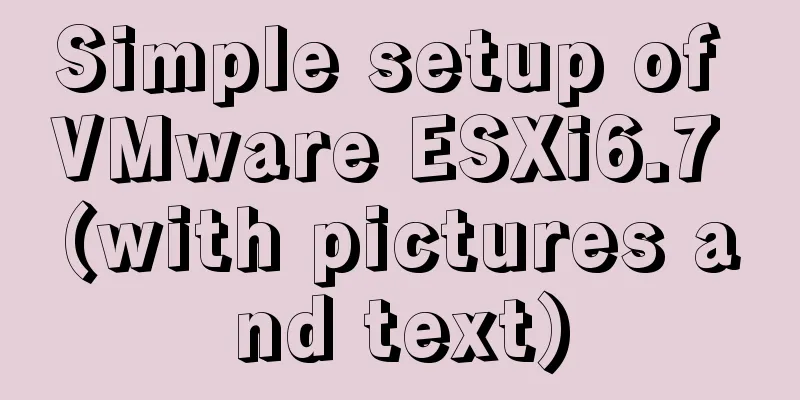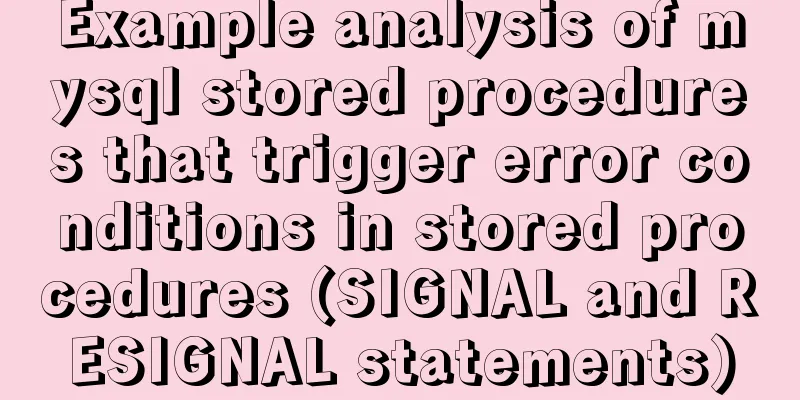Docker core and specific use of installation

|
1. What is Docker? (1) Docker is an open source tool for running applications in Linux containers. It is a lightweight "virtual machine" The logo is designed as a blue whale. The whale can be seen as a host machine, and the containers above can be understood as isolated containers, each of which contains its own application.
(2) The difference between Docker and virtual machines As a lightweight virtualization method, Docker has significant advantages over traditional virtual machines.
The reason why Docker has many advantages is inseparable from the characteristics of operating system virtualization itself. Traditional virtual machines require additional virtual machine hypervisors and virtual machine operating system layers, while Docker containers are virtualized directly on the operating system level.
(3) Docker usage scenarios Now developers need to be able to easily create applications that run on cloud platforms. They must be independent of the underlying hardware and need to be able to access these resources at any time and place. This is exactly what Docker can provide. Docker's container technology makes it easy to create a lightweight, portable, and self-sufficient container for any application on a host. Packaging applications in this container simplifies trivial repetitive tasks such as redeployment and debugging, greatly improving work efficiency. 2. Docker's core concepts and installation (1) Mirror Docker's image (mage) is the basis for creating containers. Similar to a virtual machine snapshot, it can be understood as a read-only template for the Docker container engine. For example, an image can be a complete CentOS operating system environment, called a CentOS (2) Container Dooker's container is a running instance created from an image. It can be started, stopped and deleted. Each container created is isolated and invisible to each other, ensuring the security of the platform. You can think of the container as a simplified Linux environment. Docker uses containers to run and isolate applications. (3) Warehouse The Docker repository is a place where images are stored centrally. After creating your own image, you can use the push command to upload it to a public repository or a private repository. In this way, the next time you want to use this image on another machine, you only need to pull it from the repository. (4) Install Docker If the host has internet access, you can install it directly. Configure yum [root@localhost ~]# rm -rf /etc/yum.repos.d/* [root@localhost ~]# vim /etc/yum.repos.d/a.repo [aaa] name=asd baseurl=file:///media gpgcheck=0 [root@localhost ~]# mount /dev/cdrom /media/ [root@localhost ~]# yum -y install docker After the installation is complete, you can start Docker and set it to start automatically at boot [root@localhost ~]# systemctl start docker [root@localhost ~]# systemctl enable docker Created symlink from /etc/systemd/system/multi-user.target.wants/docker.service to /usr/lib/systemd/system/docker.service. [root@localhost ~]# docker version //View Docker version Client: Version: 1.13.1 API version: 1.26 Package version: docker-1.13.1-75.git8633870.el7.centos.x86_64 Go version: go1.9.4 Git commit: 8633870/1.13.1 Built: Fri Sep 28 19:45:08 2018 OS/Arch: linux/amd64 Server: Version: 1.13.1 API version: 1.26 (minimum version 1.12) Package version: docker-1.13.1-75.git8633870.el7.centos.x86_64 Go version: go1.9.4 Git commit: 8633870/1.13.1 Built: Fri Sep 28 19:45:08 2018 OS/Arch: linux/amd64 Experimental: false Divided into server and client 3.Docker image operation (1) Search for mirrors (prerequisite: the computer has internet access) [root@localhost ~]# docker search dhcp INDEX NAME DESCRIPTION STARS OFFICIAL AUTOMATED docker.io docker.io/networkboot/dhcpd Suitable for running a DHCP server for you... 43 [OK] docker.io docker.io/joebiellik/dhcpd DHCP server running on Alpine Linux 15 [OK] docker.io docker.io/gns3/dhcp A DHCP container for GNS3 using dnsmasq 3 [OK] docker.io docker.io/instantlinux/dhcpd-dns-pxe Serve DNS, DHCP and TFTP from a small Alpi... 2 [OK] docker.io docker.io/ictu/dhcpd-tftpd dhcpd tftpd container 1 [OK] docker.io docker.io/marcelwiget/dhcptester Simple dhcp client simulation (2) Obtaining the image [root@localhost ~]# docker pull docker.io/network/dhcpd //Download the dhcp at the beginning of the above Another way is to insert the downloaded dhcp
Make a CD and insert it into the host [root@localhost ~]# mount /dev/cdrom /media/ [root@localhost ~]# cd /media/ [root@localhost media]# ls dhcp [root@localhost media]# cp dhcp / [root@localhost media]# [root@localhost /]# docker load < dhcp fccbfa2912f0: Loading layer 116.9 MB/116.9 MB e1a9a6284d0d: Loading layer 15.87 kB/15.87 kB ac7299292f8b: Loading layer 14.85 kB/14.85 kB a5e66470b281: Loading layer 5.632 kB/5.632 kB a8de0e025d94: Loading layer 3.072 kB/3.072 kB e2e29955c5aa: Loading layer 12.7 MB/12.7 MB 12e14fab4dd4: Loading layer 49.15 kB/49.15 kB 47bdfd3bbf39: Loading layer 4.096 kB/4.096 kB Loaded image: docker.io/networkboot/dhcpd:latest Download the image to your local computer (3) View image information [root@localhost /]# docker images REPOSITORY TAG IMAGE ID //Image ID CREATED SIZE docker.io/networkboot/dhcpd latest 6f98b6b9b486 19 months ago 125 MB
[root@localhost /]# docker inspect 6f98b6b9b486 \View image ID details The detailed information of the image includes creation time, system version, host name, domain name, user, volume, label, operating system, device ID and other information. [root@localhost /]# docker tag docker.io/networkboot/dhcpd dhcp:dhcp First dhcp: name Second dhcp: label (4) Delete the image [root@localhost /]# docker rmi dhcp:dhcp Untagged: dhcp:dhcp 4.Docker container operation Container is another core concept of Docker. Simply put, a container is a running instance of an image, an independently running application or a group of applications and their necessary operating environment, including file system, system library, shell environment, etc. The image is a read-only template, and the container gives this read-only template an additional writable layer (1) Creating and starting a container [root@localhost /]# docker create -it docker.io/networkboot/dhcpd /bin/bash e392026ddd186d01cbd3306acae15f2f197dc9874a84ea241d347c7fe20a0946 Common options: -i means to keep the container's input open: -t means to let Docker allocate a pseudo terminal. [root@localhost /]# docker ps -a \\View the running status of all containers CONTAINER ID IMAGE COMMAND CREATED STATUS PORTS NAMES e392026ddd18 docker.io/networkboot/dhcpd "/entrypoint.sh /b..." About a minute ago Created elegant_goldwasser The output information shows the container ID number, loaded image, running program, creation time, current status, port mapping, container name, etc. The status column "Created" indicates that the current container is newly created and is in a stopped state. [root@localhost /]# docker start e392026ddd18 \\Start the container, the ID above e392026ddd18 After the container is started, you can see that the container status column has changed to UP, indicating that the container is in the started state. (2) Container operation and termination [root@localhost /]# docker stop container ID (3) Entry of container [root@localhost /]# docker exec -it e392026ddd18 /bin/bash root@e392026ddd18:/# The user can enter commands through the created terminal and exit the container through the exit command. root@e392026ddd18:/# ls bin core entrypoint.sh home lib64 mnt proc run srv tmp var boot dev etc lib media opt root sbin sys usr root@e392026ddd18:/# exit exit (4) Export and import of containers The container is minimized, which causes some commands to be unusable, so you need to export them from the container to the local computer for configuration, and then import them into the container. The export command is as follows: [root@localhost /]# docker export e392026ddd18>/etc/dhcp/dhcpd.conf The random number is the container ID number Export the dhcp main configuration file for configuration. The import command is as follows: [root@localhost /]# docker import /etc/dhcp/dhcpd.conf > e392026ddd18 (5) Deleting a container You can use the dockerrm command to delete a terminated container. An image can contain multiple containers [root@localhost /]# docker stop e392026ddd18 \\Stop e392026ddd18 first [root@localhost /]# docker rm e392026ddd18 \\Delete e392026ddd18 again [root@localhost /]# docker ps -a CONTAINER ID IMAGE COMMAND CREATED STATUS PORTS NAMES 5. Docker Resource Control Cgroup is the abbreviation of Controlgroup, which is a mechanism provided by the Linux kernel to limit the physical resources used. These resources mainly include CPU, memory, and blkio. The following will discuss how Docker uses the Cgroup mechanism for management in these three aspects. (1) Limiting CPU usage rate For example, set the CPU usage of container 60ff4594cc73 to 20000 and set the CPU usage limit to 20%: [root@localhost ~]# echo 20000 >/sys/fs/ cgroup/ cpu/ system. slice/docker-60ff4594cc73b5474477 636b25b41f 16e1 66a3606aed22 6522d420d0c296990d. scope/cpu . cfs_ quota _us (2) Multiple tasks share the CPU in proportion For example, to run three newly created containers A, B, and C, and occupy CPU resources in a ratio of 1:1:2, you can execute it like this: [root@localhost /]# docker run -tid --cpu-shares 1024 +Mirror A [root@localhost /]# docker run -tid --cpu-shares 1024 +Mirror B [root@localhost /]# docker run -tid --cpu-shares 2048 +image C The above is the full content of this article. I hope it will be helpful for everyone’s study. I also hope that everyone will support 123WORDPRESS.COM. You may also be interested in:
|
<<: MySQL 8.x msi version installation tutorial with pictures and text
>>: Solution to the problem that the audio component of WeChat applet cannot be played on iOS
Recommend
Detailed use cases of vue3 teleport
Official Website https://cli.vuejs.org/en/guide/ ...
Basic usage analysis of Explain, a magical tool for MySQL performance optimization
Introduction MySQL provides an EXPLAIN command th...
Commonly used JavaScript array methods
Table of contents 1. filter() 2. forEach() 3. som...
Several common methods of CSS equal height layout
Equal height layout Refers to the layout of child...
Vue two same-level components to achieve value transfer
Vue components are connected, so it is inevitable...
Building the User Experience
<br />Maybe you've just come into a comp...
Linux system command notes
This article describes the linux system commands....
mySql SQL query operation on statistical quantity
I won't say much nonsense, let's just loo...
Minio lightweight object storage service installation and browser usage tutorial
Table of contents Introduction Install 1. Create ...
Use href in html to pop up a file download dialog box when clicking a link
I learned a new trick today. I didn’t know it befo...
Detailed explanation of the wonderful CSS attribute MASK
This article will introduce a very interesting at...
Example of making a butterfly flapping its wings with pure CSS3
Pure CSS3 makes a butterfly flapping its wings, s...
Solution to BT Baota Panel php7.3 and php7.4 not supporting ZipArchive
The solution to the problem that the PHP7.3 versi...
How to install and configure Docker nginx
Download Nginx image in Docker docker pull nginx ...
Add and delete table information using javascript
Getting Started with JavaScript JavaScript is a l...













